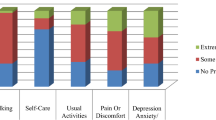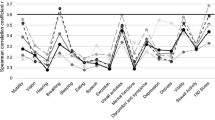Abstract
Aims
To investigate the impact of comorbid diabetes on general and angina-related quality of life (QoL) in people with angina.
Methods
We analysed data for a subset of patients with angina, from a randomised controlled trial conducted in UK primary care. SF36 scores and Seattle Angina Questionnaire scores were compared for people with and without diabetes. We adopted a robust statistical approach, using nonparametric quantile regression to adjust for the influence of potential confounders.
Results
Data were available for 904 cases of whom 181 (20%) had diabetes. Presence of comorbid diabetes was significantly associated with reduced generic QoL for all SF36 domains and Seattle Angina Questionnaire physical limitation scores (estimated regression coefficient −12.33), but not for the other angina-related scores. Greater frequency of perceived angina was strongly correlated with reduced QoL (P < 0.001) and angina frequency was similar in people with and without diabetes (P = 0.576).
Conclusions
Our results confirm the cumulative impact of having multiple chronic diseases on QoL. Though limited by the data available, our finding of similar angina frequency in patients with and without diabetes contributes to the debate regarding the influence of autonomic neuropathy on perception of angina in people with diabetes.
Similar content being viewed by others
References
Parchman, M. L., Romero, R. L., & Pugh, J. A. (2006). Encounters by patients with type-2 diabetes—complex and demanding: An observational study. Annals of Family Medicine, 4, 40–45. doi:10.1370/afm.422.
Fortin, M., Bravo, G., Hudon, C., Vanasse, A., & Lapointe, L. (2005). Prevalence of multimobidity among adults seen in family practice. Annals of Family Medicine, 3, 223–228. doi:10.1370/afm.272.
Boyd, C. M., Darer, J., Boult, C., Fried, L. P., Boult, L., & Wu, A. W. (2005). Clinical practice guidelines and quality of care for older patients with multiple comorbid diseases. Journal of the American Medical Association, 294, 716–724. doi:10.1001/jama.294.6.716.
McGuire, D. K., Emanuelson, H., Granger, C. B., Magnus, O. E., Moliterno, D. J., White, H. D., et al. (2000). Influence of diabetes mellitus on clinical outcomes across the spectrum of acute coronary syndromes. Findings from the GUSTO-IIb study. European Heart Journal, 21, 1750–1758. doi:10.1053/euhj.2000.2317.
Stamler, J., Vaccaro, O., Neaton, J. D., & Wentworth, D. (1993). Diabetes, other risk factors, and 12-year cardiovascular mortality for men screened in the Multiple Risk Factor Intervention Trial. Diabetes Care, 16, 434–444. doi:10.2337/diacare.16.2.434.
Gravely-Witte, S., De Gucht, V., Heiser, W., Grace, S. L., & Van Elderen, T. (2007). The impact of angina and cardiac history on health-related quality of life and depression in coronary heart disease patients. Chronic Illness, 3, 66–76. doi:10.1177/1742395307079192.
Pocock, S. J., Henderson, R. A., Seed, P., Treasure, T., Hampton, J. R., & RITA Trial Participants. (1996). Quality of life, employment status, and anginal symptoms after coronary angioplasty or bypass surgery. Circulation, 94, 135–142.
Bengtsson, I., Hagman, M., & Wedel, H. (2001). Age and angina as predictors of quality of life after myocardial infarction. Scandinavian Cardiovascular Journal, 35, 252–258. doi:10.1080/14017430152581369.
Gandjour, A., & Lauterbach, K. W. (1999). Review of quality-of-life evaluations in patients with angina pectoris. PharmacoEconomics, 16, 141–152. doi:10.2165/00019053-199916020-00003.
Akhras, K. S., Burch, S. P., Dedhiya, S. D., & Sood, V. C. (2000). Health related quality of life in the treatment of angina. Heart Disease, 2, 201–216.
Brorsson, B., Bernstein, S. J., Brook, R. H., & Werkö, L. (2001). Quality of life of chronic stable angina patients 4 years after coronary angioplasty or coronary artery bypass surger. Journal of Internal Medicine, 249, 47–57. doi:10.1046/j.1365-2796.2001.00782.x.
Rubin, R. R., & Peyrot, M. (1999). Quality of life and diabetes. Diabetes/Metabolism Research and Reviews, 15, 205–218. doi:10.1002/(SICI)1520-7560(199905/06)15:3≤205::AID-DMRR29≥3.0.CO;2-O
Wändell, P. E. (2005). Quality of life in patients with diabetes mellitus. Scandinavian Journal of Primary Health Care, 23, 68–74. doi:10.1080/02813430510015296.
Anderson, R. J., Freedland, K. E., Clouse, R. E., & Lustman, P. J. (2001). The prevalence of comorbid depression in adults with diabetes: A meta-analysis. Diabetes Care, 24, 1069–1078. doi:10.2337/diacare.24.6.1069.
Ali, S., Stone, M. A., Peters, J. L., Davies, M. J., & Khunti, K. (2006). The prevalence of co-morbid depression in adults with Type 2 diabetes: A systematic review and meta-analysis. Diabetic Medicine, 23, 1165–1173. doi:10.1111/j.1464-5491.2006.01943.x.
Keinänen-Kiukaanniemi, S., Ohinmaa, A., Pajunpää, H., & Koivukangas, P. (1996). Health related quality of life in diabetic patients measured by the Nottingham Health Profile. Diabetic Medicine, 13, 382–388. doi:10.1002/(SICI)1096-9136(199604)13:4≤382::AID-DIA14≥3.0.CO;2-Y
De Visser, C. L., Bilo, H. J., Groenier, K. H., de Visser, W., & Jong-Meyboom-de, B. (2002). The influence of cardiovascular disease on quality of life in type 2 diabetes. Quality of Life Research, 11, 249–261. doi:10.1023/A:1015287825660.
Nichols, G. A., & Brown, J. B. (2004). Functional status before and after diagnosis of type 2 diabetes. Diabetic Medicine, 21, 793–797. doi:10.1111/j.1464-5491.2004.01191.x.
Khunti, K., Stone, M., Paul, S., Baines, J., Gisbourne, L., Farooqi, A., et al. (2007). Disease management programme for secondary prevention of coronary heart disease and heart failure in primary care: A cluster randomised controlled trial. Heart (British Cardiac Society), 93, 1398–1405. doi:10.1136/hrt.2006.106955.
Spertus, J. A., Winder, J. A., Dewhurst, T. A., Deyo, R. A., & Fihn, S. D. (1994). Monitoring the quality of life in patients with coronary artery disease. The American Journal of Cardiology, 74, 1240–1244. doi:10.1016/0002-9149(94)90555-X.
Spertus, J. A., Winder, J. A., Dewhurst, T. A., Deyo, R. A., Prodzinski, J., McDonnell, M., et al. (1995). Development and evaluation of the Seattle Angina Questionnaire: A new functional status measure for coronary artery disease. Journal of the American College of Cardiology, 25, 333–341. doi:10.1016/0735-1097(94)00397-9.
Rivest, L. P. (1994). Statistical properties of winsorized means for skewed distributions. Biometrika, 81(2), 373–383. doi:10.1093/biomet/81.2.373.
Paul, S., Khunti, K., Stone, M., & Squire, I. (2005). Comparing parametric and non-parametric regression techniques to examine angina quality of life questionnaire: Results from a large RCT in primary care. Statistics in Healthcare 2005—RSS Conference Abstract (available online at www.rss.org.uk).
Timmis, A. D., Feder, G., & Hemingway, H. (2007). Prognosis of stable angina pectoris: Why we need larger population studies with higher endpoint resolution. Heart (British Cardiac Society), 93, 786–791. doi:10.1136/hrt.2006.103119.
Hemingway, H., Shipley, M., Britton, A., et al. (2003). Prognosis of angina with and without a diagnosis: 11 year follow up in the Whitehall II prospective cohort study. BMJ (Clinical Research Ed.), 327, 895. doi:10.1136/bmj.327.7420.895.
Dempster, M., & Donnelly, M. (2000). Measuring the health related quality of life of people with ischaemic heart disease. Heart (British Cardiac Society), 83, 641–644. doi:10.1136/heart.83.6.641.
Beaumont, J. L., Lix, L. M., Yost, K. J., & Hahn, E. A. (2006). Application of robust statistical methods for sensitivity analysis of health-related quality of life outcomes. Quality of Life Research, 15, 349–356. doi:10.1007/s11136-005-2293-1.
Fortin, M., Bravo, G., Hudon, C., Vanasse, A., Lapointe, L., Almirall, J., et al. (2006). Relationship between multimorbidity and health-related quality of life of patients in primary care. Quality of Life Research, 15, 83–91. doi:10.1007/s11136-005-8661-z.
Deaton, C., Kimble, L. P., Veledar, E., Hartigan, P., & Boden, W. E. (2006). O’Rourke Ra, Weintraub WS. The synergistic effect of heart disease and diabetes on self management, symptoms and health status. Heart & Lung, 35, 325–323. doi:10.1016/j.hrtlng.2006.05.005
Peterson, P. N., Spertus, J. A., Magid, D. J., Masoudi, F. A., Reid, K., Hamman, R. F., et al. (2006). The impact of diabetes on one-year health status outcomes following acute coronary symdromes. BMC Cardiovascular Disorders, 6, 41. doi:10.1186/1471-2261-6-41.
Kannel, W. B., & Abbott, R. D. (1984). Incidence and prognosis of unrecognised myocardial infarction. An update on the Framingham study. The New England Journal of Medicine, 311, 1144–1147.
Margolis, J. R., Kannel, W. S., Feinleib, M., Dawber, T. R., & McNamara, P. M. (1973). Clinical features of unrecognised myocardial infarction—silent and symptomatic. Eighteen year follow-up: the Framingham study. The American Journal of Cardiology, 32, 1–7. doi:10.1016/S0002-9149(73)80079-7.
Deanfield, J. E., Maseri, A., Selwyn, A. P., Ribeiro, P., Chierchia, S., Krikler, S., et al. (1983). Myocardial ischemia during daily life in patients with stable angina: Its relation to symptoms and heart rate changes. Lancet, 2, 753–758. doi:10.1016/S0140-6736(83)92295-X.
Wackers, F. J. T., Young, L. H., Inzucchi, S. E., Chyun, D. E., Davey, J. A., Barret, E. J., et al., & DIAD Investigators. (2004). Detection of silent myocardial ischemia in asymptomatic diabetic subjects. The DIAD Study. Diabetes Care, 27, 1954–1961. doi:10.2337/diacare.27.8.1954
Ambepityia, G., Kopelman, P. G., Ingram, D., Swash, M., Mills, P. D., & Timmis, A. D. (1990). Exertional myocardial ischemia in diabetes: a quantitative analysis of anginal perceptual threshold and the influence of autonomic function. Journal of the American College of Cardiology, 15, 72–77.
Bradley, R. F., & Schonfield, A. (1962). Diminished pain in diabetic patients with acute myocardial infarction. Geriatrics, 12, 322–326.
Murray, D. P., O’Brien, T., Mulrooney, R., & O’Sullivan, D. J. (1990). Autonomic dysfunction and silent myocardial ischaemia on exercise testing in diabetes mellitus. Diabetic Medicine, 7, 580–584.
Faerman, I., Faccio, E., Milei, J., Nunez, R., Jadinsky, M., Fox, D., et al. (1977). Autonomic neuropathy and painless myocardial infarction in diabetic patients. Histologic evidence of their relationship. Diabetes, 26, 1147–1158. doi:10.2337/diabetes.26.12.1147.
Niakan, E., Harati, Y., Rolask, L. A., Comstock, J. P., & Rokey, R. (1986). Silent myocardial infarction and diabetic cardiovascular autonomic neuropathy. Archives of Internal Medicine, 146, 2229–2230. doi:10.1001/archinte.146.11.2229.
Koistinen, M. J. (1990). Prevalence of asymptomatic myocardial ischaemia in diabetic subjects. BMJ (Clinical Research Ed.), 301, 92–95.
Callaham, P. R., Froelicher, V. F., Klein, J., Risch, M., Dubach, P., & Friis, R. (1989). Exercise-induced silent ischemia: Age, diabetes mellitus, previous myocardial infarction and prognosis. Journal of the American College of Cardiology, 14, 1175–1180. doi:10.1016/0735-1097(89)90413-0.
Caracciolo, E. A., Chaitman, B. R., Forman, S. A., Stone, P. H., Bourassa, M. G., Sopko, G., et al., & ACIP Investigators. (1996). Diabetics with coronary disease have a prevalence of asymptomatic ischemia during exercise treadmill testing and ambulatory ischemia monitoring similar to that of nondiabetic patients. Circulation, 93, 2097–2105.
Author information
Authors and Affiliations
Corresponding author
Rights and permissions
About this article
Cite this article
Stone, M.A., Khunti, K., Squire, I. et al. Impact of comorbid diabetes on quality of life and perception of angina pain in people with angina registered with general practitioners in the UK. Qual Life Res 17, 887–894 (2008). https://doi.org/10.1007/s11136-008-9363-0
Received:
Accepted:
Published:
Issue Date:
DOI: https://doi.org/10.1007/s11136-008-9363-0




